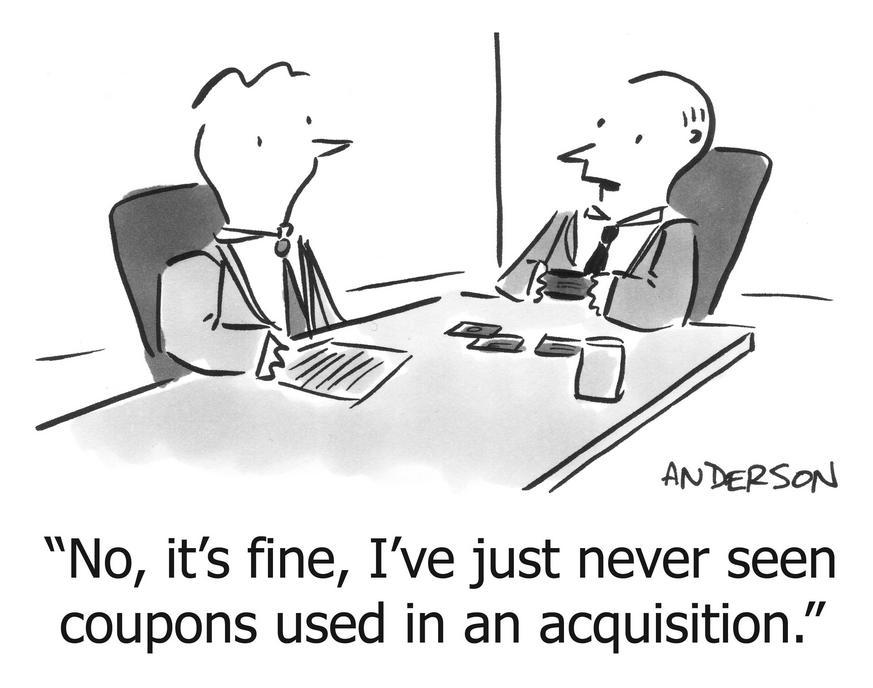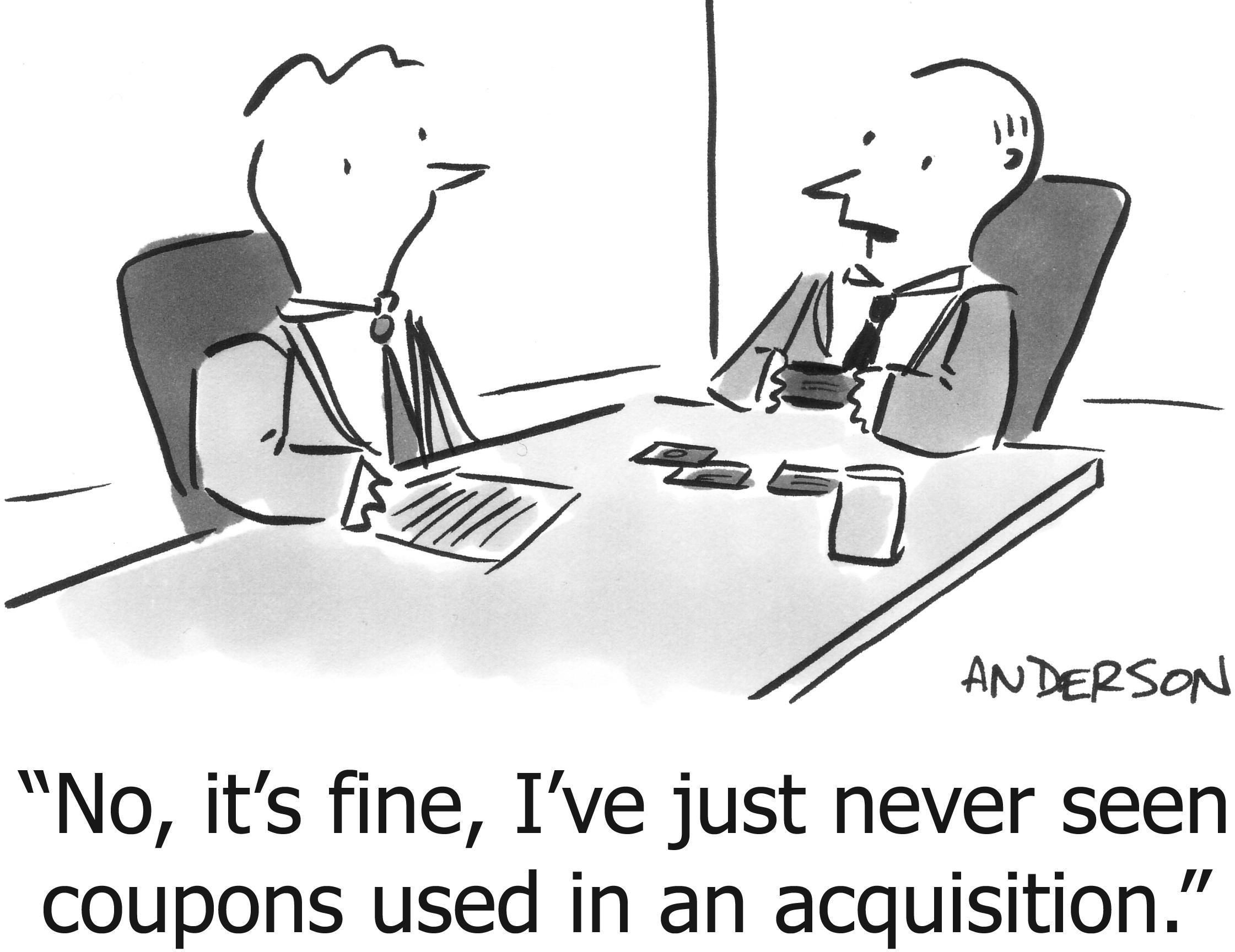Discount gambit
Which of these pricing strategies is more persuasive?
- If you buy now, I’ll give you a discount.
- The price is going up, but if you buy now I will lock in your rate.
Both are types of discount. The typical software sales strategy is #1. It’s often applied to get the customer to “close” before the end of the month or quarter or some other arbitrary time boundary.
At first blush it seems harder to persuade with #2. After all, #1 means the customer pays less than #2, because #2 isn’t a real discount—it’s a discount against an imagined future price.
But for me, the evidence is overwhelmingly in favor of #2. Here’s why, from the point of view of the customer.
In strategy #1 there’s a discount if I “act now.” Hmm, so that means the “price” wasn’t really the price after all. The “price” must have included a nice slice of pure profit that apparently you’re willing to forego. So you were gouging me before? And the only reason I found out about it is that it happens to be the end of the quarter?
Thus #1 breeds mistrust—the opposite of what you’re trying to establish with me, your customer. In #2 you’re looking out for my interests.1 You’re cluing me in that there might be a rate increase, and you’re actively protecting me from it. Sure, I know there may not be an increase, or it may not come for a while. But it’s still protection, not a gouge that you graciously chose to reveal.
1 This is an example of the “Love” type of WTP (Willingness-to-pay)
Four years ago I was trialing software called .TEST from Parasoft. It was buggy; even after hours of remote desktop control with tech support we couldn’t get it to stay up long enough to scan my code.
But the salesman was persistent. The conversation went like this, minus many minutes of sales-filler-language on his end of the phone:
“How much will this cost me?”
“$20,000.”
“Wow, I thought you were going to say $2,000. That’s way out of my price range for one person and this product. In fact, I’ve looked at FxCop and NUnit and it seems to me I can do the same thing with free tools. I was willing to pay for some convenience, but not that much.”
“Let me see what I can do.”
“No nevermind, it’s, like, an order of magnitude problem.”
He called back the next day.
“$1,500.”
I didn’t buy. I talked to someone who did, though. A reference customer. That guy said he paid $20,000. I asked how he liked it and whether he encountered the crash problems I was seeing. He said they hadn’t installed it yet, but the demo looked great. I made a mental note to try to understand the mentality and budget that forks out $20,000 for a nice demo.
But getting back to the point. If he can go from $20,000 to $1,500, maybe he will go to $1,000. Yes, this strategy means often you will extract extra money from me. But it also means I don’t know where the floor is, and I have every incentive to haggle. The process drags out, ending at gunpoint. Meanwhile your “customer relationship” is now more of a “hostage situation.”
So let me get this straight: It’s better to get an extra 10% on every order, but create an adversarial environment with me, your cherished customer? This is enterprise sales, right, where the pilot is 30 seats and the roll-out is 2,000? And you’re going to risk pissing me off over 10% on the 30-seat part?
And now imagine if I had called back that reference customer and told him he could’ve had it for $1,500? Yet another problem with discounting—word gets around, meaningless differences in pricing is unfair, and now I, the customer, see you as plain old dishonest.
Goodbye 2,000-seat order.
Even if we set the honesty/relationship argument aside, there’s the matter of image.
What kind of company provides a discount? Wal-Mart, Target, Walgreens. Try to get quotes for Microsoft or Oracle or IBM products for 1000 desktops. Everything’s negotiable, everything’s discountable. At best it conjures images of haggling and struggle; at worst of low-quality or the desperate need to “meet numbers” at the expense of everything else.
Which companies don’t discount, ever? Apple, Google, Constant Contact. No discounts on iPhones. No haggling over AdWord prices. What’s the image? Desirable. The best. Worth paying for. The leader doesn’t have to compromise. The leader isn’t desperate for orders.
What kinds of customers do you attract through discounts, coupons, and “act now” language? The ones that truly find a lot of value from your product? The ones whose opinions you care about when you’re researching the next round of features? The ones who will love your brand, and increase how much they’re spending with you over time? Strategy #1 attracts the least-valuable customers and repels the best ones, while establishing a weak brand.
Strategy #2 implies growth. You’ve planted “higher prices” in my head now. “Supply” in software is unlimited, so that must mean “demand” is increasing. The customer won’t go through that calculus, but it certainly feels like the product is becoming more valuable. Discounts feel like unloading unwanted product; price increases feel like success.
Strategy #2 implies I’m part of a club. I’ve gotten in early, on the ground floor, before the product explodes in popularity and prices go up. And I’m rewarded for this support and loyalty with price protection. A “thank-you” from because I was part of it, because I was there before you were big and expensive, because I took that risk with you. That’s actually a good reason to give some a discount, and here you are, proactively giving it.
So there it is. #1 means less money now, an adversarial relationship, a never-ending struggle over money, and a message that maybe the product needs a discount to be desirable. #2 means more money now, a consistent and fair pricing policy, an inclusive, special customer relationship, and a message of market leadership and growth.
So why do 90% of software companies pick #1?
https://longform.asmartbear.com/discount-gambit/
© 2007-2025 Jason Cohen
 @asmartbear
@asmartbear ePub (Kindle)
ePub (Kindle)
 Printable PDF
Printable PDF







